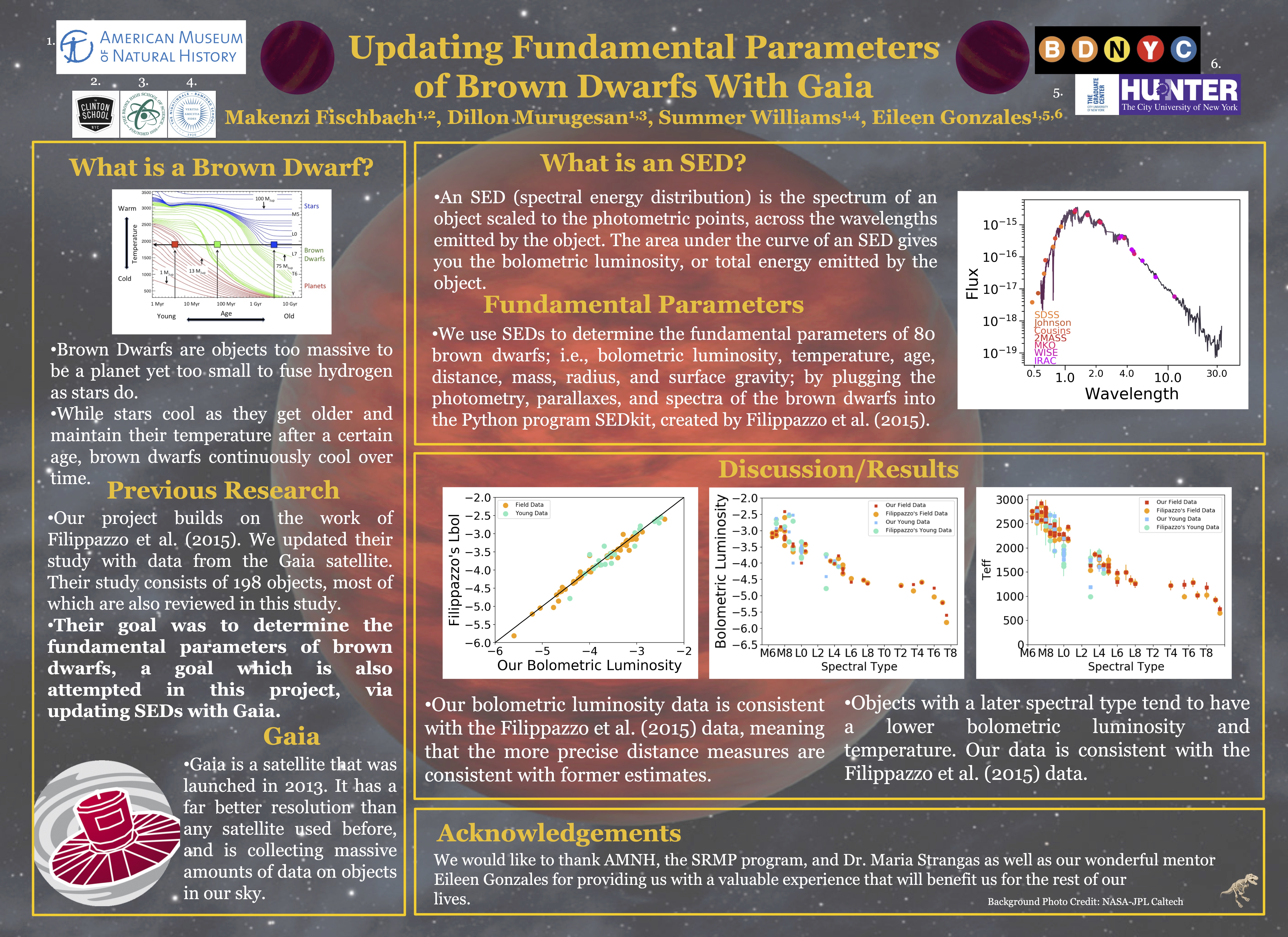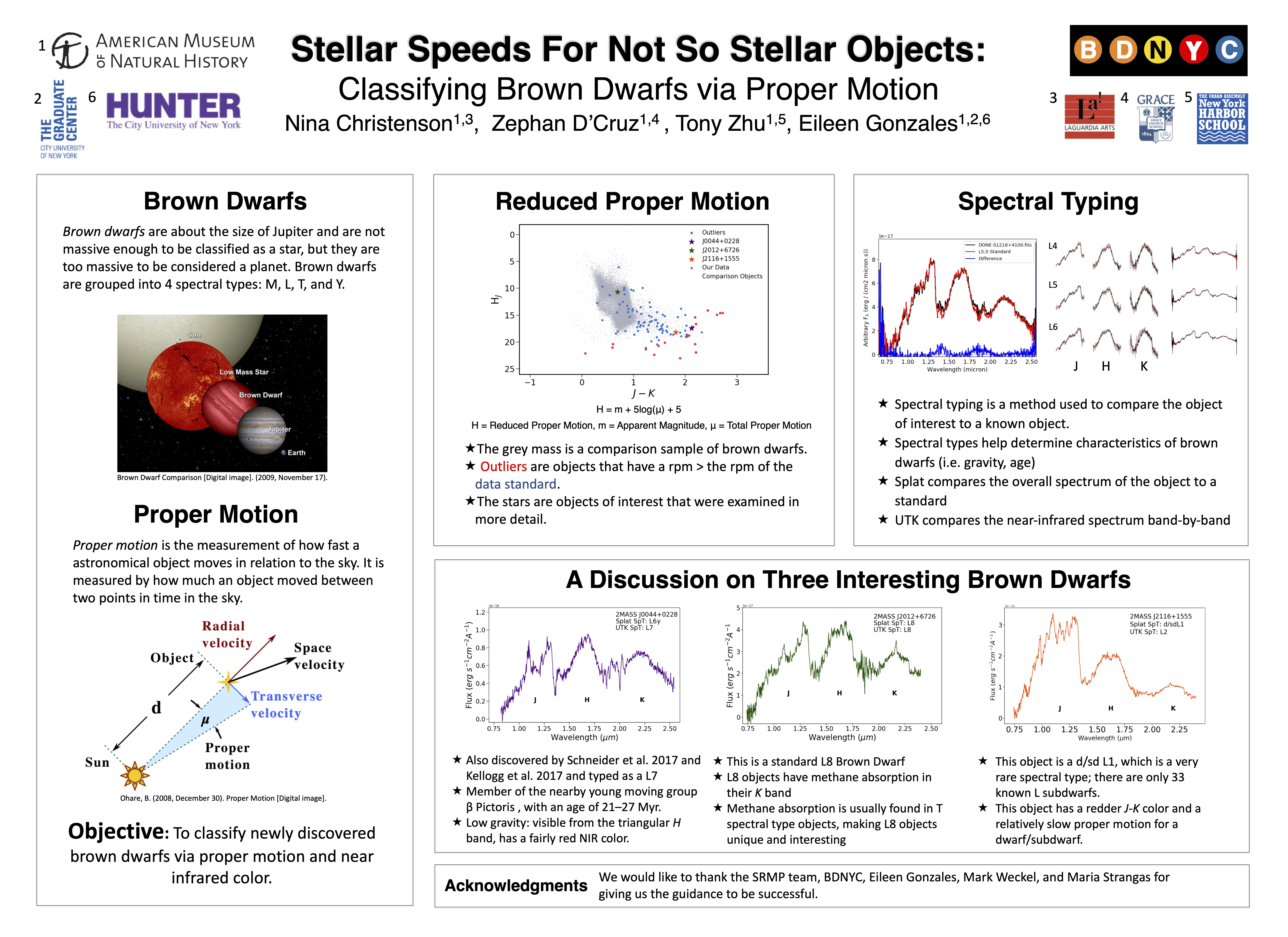Research

Current Research
My work combines both observational and theoretical based approaches via spectral energy distributions and atmospheric retrievals to understand the complex atmospheres of substellar sources. Presently, I am using the Brewster code written by Dr. Ben Burningham to explore the atmopsheres of these sources. Below are some of my current projects using Brewster.
- Characterizing Atmospheres at the Intersection of Directly-Imaged Exoplanets and Brown Dwarfs
- Retrieval of the first substellar subdwarf: A cloud-free SDSS J1256
- Retrieval of the d/sdL7+T7.5p binary SDSS J1416+1348AB
- Comparative Retrievals of Subdwarfs
Past Research
As part of my dissertation work at the CUNY Graduate Center, I focused on determining fundamental parameters of brown dwarfs and low-mass stars. I worked with the BDNYC Research group, where I was advised by Dr. Jackie Faherty at the American Museum of Natural History and Dr. Ben Burningham at the University of Hertfordshire.
Determing Fundamental Parameters of Brown Dwarfs and low-mass stars via SED fitting
Understanding subdwarfs via a case study of SDSS J125637.13-022452.4
In this work, I used distance-calibrated spectral energy distributions (SEDs) to compare the subdwarf SDSS J1256-0224 to objects of the same temperature and bolometric luminosity. In doing so we found that clouds help change the overall SED shape, while gravity and metallicity features dominate the variations seen in the NIR bands. We also compared SDSS J1256 to subdwarfs with parallaxes and found that temperature does not correlate linearly with spectral type. Read the publication here.
Is Trappist-1 a unique host star?
As Trappist-1 hosts seven rocky planets, with four in its habitable zone, we hope to understand how common this type of system is. Trappist-1 is currently thought to be an older object, with an age of ~7.6 Gyr, however, it receives an INT-G classification when using the Allers & Liu 2013 indices. This work compares Trappist-1 to a sample of objects of similar temperature, bolometric luminosity, or gravity classification in an effort to understand the age of this fascinating system. Read the publication here.
Testing the Refurbished Leuschner 30-inch Telescope and it exoplanet detection capabilites
For my master's thesis work at San Francisco State University, I worked with Dr. Adrienne Cool on a project that was one part telescope testing and one part research. I spent half of my time testing the pointing, tracking, and focusing abilities of the then recently refurbished Lesuchner 30-inch Telescope, located outside of Lafayette, CA. The other half of my time was spent on seeing if the Leuschner telescope could be used to detect transiting exoplanets. We were able to detect transits of a few bright known hot Jupiters.
Blazhko Effect in RR Lyrae Stars
For my undergraduate Senior thesis at Michigan State University, I worked with Dr. Horace Smith on determining light curves and periods for three variable stars. The project's goals were to look for the Blazhko effect in the light curves of RR Lyrae stars and to build data for the relationship between the shape of the light curve and the metallicity in the SLOAN filters.
Student Research
Current Students
Currently, I am working with Jasmine Ramirez, a senior at UConn, on incorprtating and testing new alkali opacites into Brewster. Our goal is to include optical data into our retrievals as it has metallicity indicators that are not visible in the near-infrared. We currently, however, exclude optical data due to the large impact the KI pressure broadening at 0.77 microns has on the pseudo-continuum shape. Jasmine is retrieving a varitey of brown dwarfs using the latest Allard alkali treatment to examine the impact these upadated alaklies have on our retrieval models.
As a way to investigate the formation and evoluton of brown dwarfs, I am also working with Celia Toral, a Cornell undergraduate. Celia is retrieving the widely-separated WISE 2150AB system to examine its atmospheric abundances, cloud properties, and C/O ratio-- a tracer for the formation history of the system.
Past Students
From 2017-2019, I mentored six high school students through the Science Research Mentoring Program (SRMP) the American Museum of Natural History (AMNH). This program consists of a year-long internship for high school students to work with a researcher at the museum on a project related to their work. Students also attend monthly advisories where they develop other skills to be successful in research and their future careers.
SRMP 2018-2019: Updating Fundamental Parameters Of Brown Dwarfs with Gaia
This 2018-2019 group created updated SEDs for field objects in the Filipazzo et al. 2015 sample using new Gaia DR2 parallaxes and medium-resolution NIR spectra. With these updated SEDs, we they improved values for field dwarf fundamental parameters. They also learned how to use the BDNYC Database, a large database of brown dwarfs containing parallaxes, spectra, photometry, and more. Below is their final presentaion poster.

SRMP 2017-2018: Stellar Speeds for Not So Stellar Objects
They 2017-2018 group spent their time examing newly discovered brown dwarfs via a proper motion search. The group created proper motion diagrams and spectral typed a small sample of objects in order to understand why these objects may have been missed in previous studies. Below is their final symposium poster.
